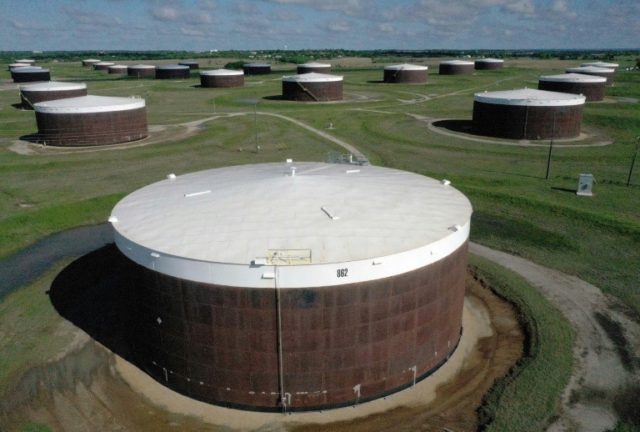Cushing (United States) (AFP) – Using his fleet of drones, Dale Parrish tracks one of the most sensitive data points in the oil world: the amount of crude stored in giant steel tanks in Cushing, Oklahoma.
The black liquid can’t be seen from outside the structures, so Parrish and his colleagues make drone flights four times a week, taking color and infrared images that can track the quantities within.
The West Texas Intermediate oil stored in the small town in the midwestern United States is used as a reference price for crude bought and sold by refiners in Asia, hedge funds in London and traders in New York.
But the COVID-19 pandemic, with its stay-at-home orders and flight cancelations, has paralyzed the global economy, collapsing demand for fuel even as oil wells keep pumping.
That means the tanks in rural Cushing — a town of just 7,500 people — have filled up at record speed, making financial markets quake.
“Right now, there’s no more storage available to be purchased. That’s where we can come in, to find out when that might happen,” Parrish told AFP.
On paper, investors buy and sell oil all the time, but face a monthly deadline to either sell it or find somewhere to store it.
But as storage space became more and more scare last month, the unimaginable happened: desperate traders had to pay someone to take possession of the oil, and on April 20 the price of a barrel of WTI turned negative for the first time in history.
Ahead of the government
An experienced drone pilot, Parrish begins his flights from the parking lot of an abandoned school in front of a set of storage tanks.
He counted 384 in total, distributed in the south and north of the city, along roads that are not all paved. There is no other way into the fenced lots without authorization by the owners, oil giants like Enbridge, Magellan or BP.
The size of the tanks varies, but they can hold on average the equivalent of 250,000 barrels of crude, brought in from Canada, Texas or Wyoming through about 20 pipelines topped with colorful valves and taps that emerge from the ground at intervals.
The US Energy Information Administration (EIA) releases data every Wednesday on the volume of oil stored in Cushing, information which can move the markets.
But Parrish’s firm Hover Visions sells images to his own clients to give them “a heads up on what we believe EIA will show, so that they can invest appropriately.”
“There is a prediction they’ll be 95 percent full by the end of May. Whether or not that will happen, I don’t know, but it will, in my estimation, be close.”
That would roil oil markets once again.
South of town, workers are busy building a dozen more tanks at the new Wildhorse terminal complex, but those won’t have any impact on the storage shortage until they are ready.
‘Pipeline crossroads of the world’
The fate of the city has been linked to oil since drilling started there at the beginning of the 20th century, and Cushing was once the site of now-closed refineries, city manager Terry Brannon said.
Main Street is lined with humble but well-maintained shops and restaurants. In front of city hall, there is a section of white pipeline, inscribed with Cushing’s nickname: “Pipeline crossroads of the world.”
While Cushing has always stored oil, the storage business has exploded in the past 15 years, Brannon said, while new techniques for extracting oil and shale gas has sent US crude output soaring.
The sudden interest in his city “is exciting,” he admits, but the town faces everyday realities, including trying to control the spread of the coronavirus and manage the hard economic times.
Seeing oil prices turn negative “was painful because I knew the impact, not just the financial impact for the city, but the financial impact for people who are employed in an industry.”

COMMENTS
Please let us know if you're having issues with commenting.